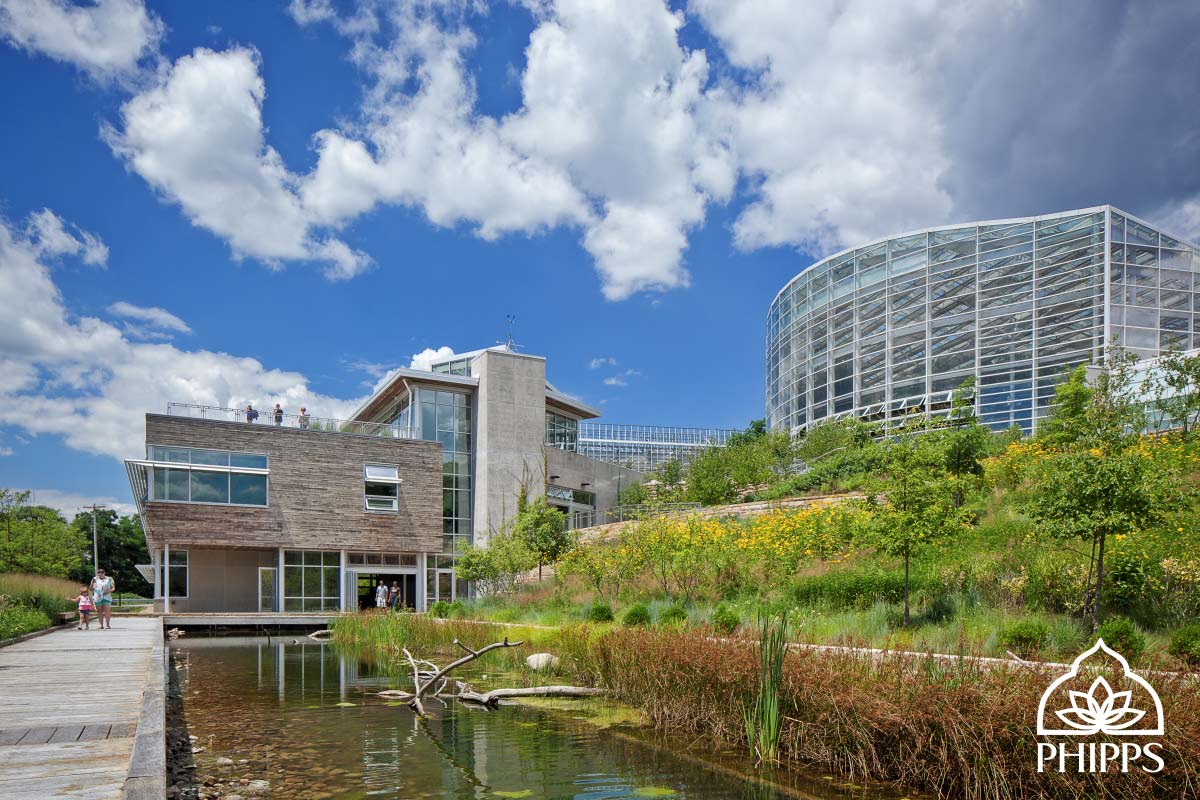Phipps Conservatory Achieves 56% Reduction in Carbon Emissions Since 2005
For Immediate Release: Tues., Sept. 12
Contact: Julie LaBar | Director of Marketing and Communications
412/638-6008 ǀ jlabar@phipps.conservatory.org
Phipps Conservatory Achieves 56% Reduction in Carbon Emissions Since 2005
A global model for sustainability, Phipps quantifies environmental impact and looks forward, further expanding its Living Campus.

Pittsburgh, Pa. — Phipps Conservatory and Botanical Gardens has reduced its carbon dioxide emissions since 2005 by 56% per square foot. This significantly exceeds the Paris Climate Agreement goal of a 26 – 28% reduction, making best efforts to reduce emissions by 28% by 2025. While expanding by more than 100,000 square feet since 1995, Phipps has reduced its carbon footprint through the use of renewable energy solutions and the most sustainable, technologically-advanced building designs.
Phipps continues the expansion of its Living Campus this month, revitalizing a former public works building built on a brownfield to develop a fully-sustainable Exhibit Staging Center (ESC). Designed to be net-positive energy and net-zero water, the building will feature a workshop for horticulture and facilities staff in preparation for seasonal flower shows and exhibits, in addition to allowing visitors behind-the-scenes access to a facilities prop workshop with interactive elements, and many other features.
“Phipps Conservatory is committed to a regenerative, healthy future, serving as a model for human and environmental well-being to nearly half a million visitors from around the world every year,” stated Phipps’ Executive Director Richard V. Piacentini. “As one example, the Center for Sustainable Landscapes at Phipps is the only building to attain four of the world’s highest sustainable building certifications. Through additional recent expansions and the future Exhibit Staging Center, Phipps continues to demonstrate what is possible as a sustainability leader and innovator.”
Phipps’ noted sustainability certifications include the Living Building Challenge, accredited through the International Living Future Institute (ILFI) for projects that meet the highest standard for environmental performance while ensuring healthy, high performance spaces. The new ESC facility is on track to become a Living Building Challenge-certified building, adding a renovation building type to new construction and modular building certifications across Phipps’ campus.
ILFI’s 2017 Living Product Expo, being held in Pittsburgh today through Thurs., Sept. 14, highlights high impact Living Building Challenge projects like Phipps and fosters innovative new ones, bringing together manufacturers, designers, scientists and subject matter experts with a shared vision for a regenerative, healthy future. Phipps proudly supports ILFI’s Living Product Expo.
To show guests that everyone can make a measurable difference, Phipps initiated the Make the Switch at Phipps! Green Power Drive this year. When guests switch their home electricity source to renewable, fossil-free energy during their Conservatory visit, they receive a free year-long family membership to Phipps. Year to date, over 1,500 guests have made the switch. Powering the average Pennsylvania home emits nearly 8 tons of carbon dioxide annually. As a result, at the end of each year, these guests will have prevented 11,850 tons of carbon dioxide emissions which is equivalent to preventing 24,889 barrels of oil from being burned.
Among organizations registered with the EPA’s Green Power Partnership, Phipps is one of only six institutions in the Museums, Parks and Zoos category and the only public garden that uses 100% renewable energy.
For more information on Phipps’ sustainability leadership and commitment, visit phipps.conservatory.org/green-innovation.
###
About Phipps: Founded in 1893, Phipps Conservatory and Botanical Gardens in Pittsburgh, Pa. is a green leader among public gardens with a mission to inspire and educate all with the beauty and importance of plants; to advance sustainability and promote human and environmental well-being through action and research; and to celebrate its historic glasshouse. Learn more: phipps.conservatory.org.
ǀ Twitter ǀ Facebook ǀ YouTube ǀ
Photos © Paul g. Wiegman; Denmarsh Photography, Inc.


